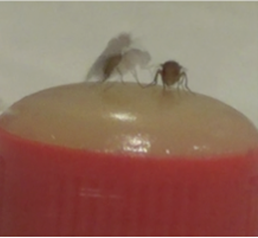By Rachel Monyak and Edward A. Kravitz
It is commonly believed that male and female animals use aggression to gain control of resources such as food or mates. Both male and female fruit flies fight other flies of the same sex for desirable food sources, but they do not fight using the same strategies. Male flies lunge, a dramatic behavior in which the fly rises up on his hind legs and rapidly strikes down on his opponent. In contrast, female flies primarily fight using head butts, a more moderate behavior in which they move forward horizontally and strike their opponent with their head. It is not known why male and female flies use different strategies when fighting or what causes them to initiate these differing behaviors.

A masculinized female fly lunges, a behavior normally performed by males.
To more deeply analyze the reasons for male and female aggressive behavior, we masculinized a portion of the neurons in the brains of female flies and paired them with male or female opponents. Surprisingly, we found that the masculinized females switched their fighting style based on the sex of their opponent. When paired with female opponents, they used female aggressive patterns of behavior, but when paired with male opponents, they used male aggressive patterns. The switch in aggressive behavior could be explained by differences in pheromones on the surfaces of males and females, the chemical signals that help flies sense the sex of an opponent. Male pheromones may have triggered the masculinized females to start fighting using male patterns of aggression, but pheromonal signals alone cannot fully explain the switch. When we examined the dynamics of entire fights, we found that the females initially fought males with female aggression patterns and only switched to male patterns part-way through the fight. This observation suggests that as yet unidentified behavioral cues given off by males may have caused the masculinized females to alter their aggressive strategy.
The finding that both behavioral and pheromonal cues may cause the masculinized females to switch their aggressive strategy helps us understand the signals that control the usage of male and female aggressive behavior. More broadly, these studies further our knowledge of how environmental signals are perceived by neurons and how different behavioral outputs are encoded in the brain.
Rachel Monyak is a postdoctoral fellow in the Kravitz Lab at Harvard Medical School
Edward Kravitz is the George Packer Berry Professor of Neurobiology at Harvard Medical School
Learn more in the original research article:
Masculinized Drosophila females adapt their fighting strategies to their opponent.
Monyak RE, Golbari NM, Chan YB, Pranevicius A, Tang G, Fernández MP, Kravitz EA. J Exp Biol. 2021 Mar 25;224(Pt 6):jeb238006. doi: 10.1242/jeb.238006. PMID: 33568440; PMCID: PMC8015213.
News Types: Community Stories
